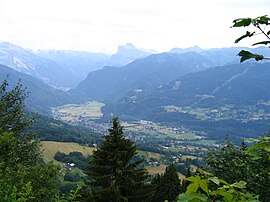Samoëns
| Samoëns | ||
|---|---|---|

A general view of Samoëns
|
||
|
||
| Coordinates: 46°05′05″N 6°43′41″E / 46.0847°N 6.7281°ECoordinates: 46°05′05″N 6°43′41″E / 46.0847°N 6.7281°E | ||
| Country | France | |
| Region | Auvergne-Rhône-Alpes | |
| Department | Haute-Savoie | |
| Arrondissement | Bonneville | |
| Canton | Samoëns | |
| Government | ||
| • Mayor (2014–2020) | Jean-Jacques Grandcollot | |
| Area1 | 97.29 km2 (37.56 sq mi) | |
| Population (2014)2 | 2,340 | |
| • Density | 24/km2 (62/sq mi) | |
| Time zone | CET (UTC+1) | |
| • Summer (DST) | CEST (UTC+2) | |
| INSEE/Postal code | 74258 /74340 | |
| Elevation | 671–2,665 m (2,201–8,743 ft) (avg. 710 m or 2,330 ft) |
|
|
1 French Land Register data, which excludes lakes, ponds, glaciers > 1 km² (0.386 sq mi or 247 acres) and river estuaries. 2Population without double counting: residents of multiple communes (e.g., students and military personnel) only counted once. |
||
1 French Land Register data, which excludes lakes, ponds, glaciers > 1 km² (0.386 sq mi or 247 acres) and river estuaries.
Samoëns (French pronunciation: [samwɛ̃]) is a commune in the Haute-Savoie department in the Auvergne-Rhône-Alpes region in south-eastern France. It is the principal commune for the canton which bears its name. The town of Samoëns is located in the Vallée du Giffre (Giffre Valley) in the French Alps.
Stone has long been a traditional feature of the Upper Giffre Valley which is dotted with limestone quarries (hardness coefficient, 13). To supplement their income from farming, the men in the region used to work stone.
In 1659, there were so many frahans (the local name for stonecutters and masons) in Samoëns and their expertise was so well known that they set up a very famous brotherhood. It engaged in charity work, taking care of the sick and training young apprentices in its own school of draughtsmen, which had an extensive library.
The members of the brotherhood of masons and stonecutters in Samoëns were contacted for leading construction projects. They worked with Vauban on his fortifications, were commissioned by Napoleon Bonaparte to build canals in Saint-Quentin, and worked in Givors and even further afield, in Poland, Louisiana and Australia.[citation needed]
To ensure that they were not understood by outsiders when talking to each other, they used their own dialect, called mourmé.
Evidence of their work can be seen all over the village, in its architecture. Even now, there are a number of stonecutters upholding the tradition in Samoëns and the brotherhood has become a cultural association, the Société des Maçons.
...
Wikipedia



